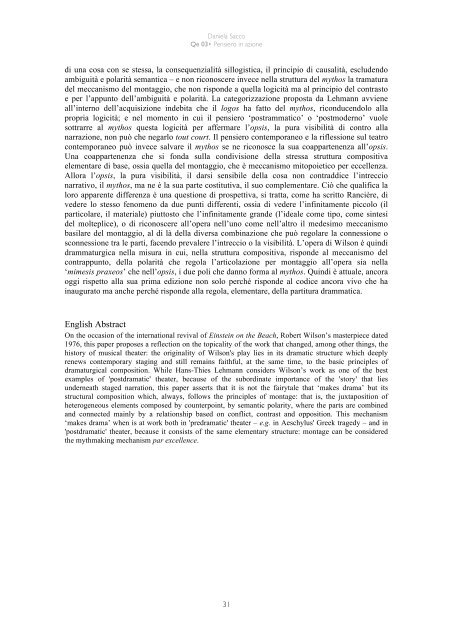Daniela Sacco, Pensiero in azione. Bertolt Brecht ... - Engramma
Daniela Sacco, Pensiero in azione. Bertolt Brecht ... - Engramma
Daniela Sacco, Pensiero in azione. Bertolt Brecht ... - Engramma
Create successful ePaper yourself
Turn your PDF publications into a flip-book with our unique Google optimized e-Paper software.
<strong>Daniela</strong> <strong>Sacco</strong><br />
Qe 03• <strong>Pensiero</strong> <strong>in</strong> <strong>azione</strong><br />
di una cosa con se stessa, la consequenzialità sillogistica, il pr<strong>in</strong>cipio di causalità, escludendo<br />
ambiguità e polarità semantica – e non riconoscere <strong>in</strong>vece nella struttura del mythos la tramatura<br />
del meccanismo del montaggio, che non risponde a quella logicità ma al pr<strong>in</strong>cipio del contrasto<br />
e per l’appunto dell’ambiguità e polarità. La categorizz<strong>azione</strong> proposta da Lehmann avviene<br />
all’<strong>in</strong>terno dell’acquisizione <strong>in</strong>debita che il logos ha fatto del mythos, riconducendolo alla<br />
propria logicità; e nel momento <strong>in</strong> cui il pensiero ‘postrammatico’ o ‘postmoderno’ vuole<br />
sottrarre al mythos questa logicità per affermare l’opsis, la pura visibilità di contro alla<br />
narr<strong>azione</strong>, non può che negarlo tout court. Il pensiero contemporaneo e la riflessione sul teatro<br />
contemporaneo può <strong>in</strong>vece salvare il mythos se ne riconosce la sua coappartenenza all’opsis.<br />
Una coappartenenza che si fonda sulla condivisione della stressa struttura compositiva<br />
elementare di base, ossia quella del montaggio, che è meccanismo mitopoietico per eccellenza.<br />
Allora l’opsis, la pura visibilità, il darsi sensibile della cosa non contraddice l’<strong>in</strong>treccio<br />
narrativo, il mythos, ma ne è la sua parte costitutiva, il suo complementare. Ciò che qualifica la<br />
loro apparente differenza è una questione di prospettiva, si tratta, come ha scritto Rancière, di<br />
vedere lo stesso fenomeno da due punti differenti, ossia di vedere l’<strong>in</strong>f<strong>in</strong>itamente piccolo (il<br />
particolare, il materiale) piuttosto che l’<strong>in</strong>f<strong>in</strong>itamente grande (l’ideale come tipo, come s<strong>in</strong>tesi<br />
del molteplice), o di riconoscere all’opera nell’uno come nell’altro il medesimo meccanismo<br />
basilare del montaggio, al di là della diversa comb<strong>in</strong><strong>azione</strong> che può regolare la connessione o<br />
sconnessione tra le parti, facendo prevalere l’<strong>in</strong>treccio o la visibilità. L’opera di Wilson è qu<strong>in</strong>di<br />
drammaturgica nella misura <strong>in</strong> cui, nella struttura compositiva, risponde al meccanismo del<br />
contrappunto, della polarità che regola l’articol<strong>azione</strong> per montaggio all’opera sia nella<br />
‘mimesis praxeos’ che nell’opsis, i due poli che danno forma al mythos. Qu<strong>in</strong>di è attuale, ancora<br />
oggi rispetto alla sua prima edizione non solo perché risponde al codice ancora vivo che ha<br />
<strong>in</strong>augurato ma anche perché risponde alla regola, elementare, della partitura drammatica.<br />
English Abstract<br />
On the occasion of the <strong>in</strong>ternational revival of E<strong>in</strong>ste<strong>in</strong> on the Beach, Robert Wilson’s masterpiece dated<br />
1976, this paper proposes a reflection on the topicality of the work that changed, among other th<strong>in</strong>gs, the<br />
history of musical theater: the orig<strong>in</strong>ality of Wilson's play lies <strong>in</strong> its dramatic structure which deeply<br />
renews contemporary stag<strong>in</strong>g and still rema<strong>in</strong>s faithful, at the same time, to the basic pr<strong>in</strong>ciples of<br />
dramaturgical composition. While Hans-Thies Lehmann considers Wilson’s work as one of the best<br />
examples of 'postdramatic' theater, because of the subord<strong>in</strong>ate importance of the 'story' that lies<br />
underneath staged narration, this paper asserts that it is not the fairytale that ‘makes drama’ but its<br />
structural composition which, always, follows the pr<strong>in</strong>ciples of montage: that is, the juxtaposition of<br />
heterogeneous elements composed by counterpo<strong>in</strong>t, by semantic polarity, where the parts are comb<strong>in</strong>ed<br />
and connected ma<strong>in</strong>ly by a relationship based on conflict, contrast and opposition. This mechanism<br />
‘makes drama’ when is at work both <strong>in</strong> 'predramatic' theater – e.g. <strong>in</strong> Aeschylus' Greek tragedy – and <strong>in</strong><br />
'postdramatic' theater, because it consists of the same elementary structure: montage can be considered<br />
the mythmak<strong>in</strong>g mechanism par excellence.<br />
31











